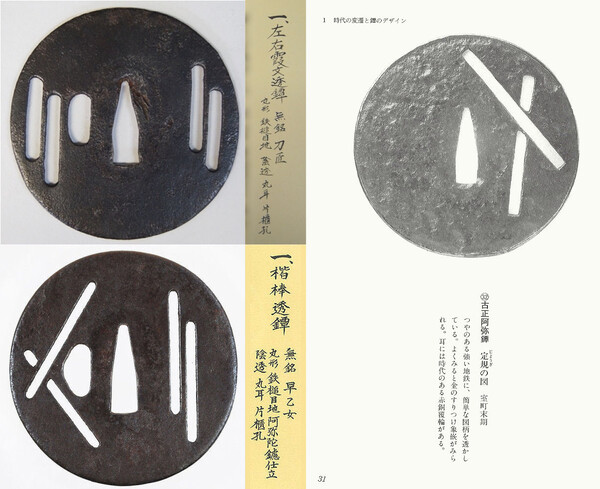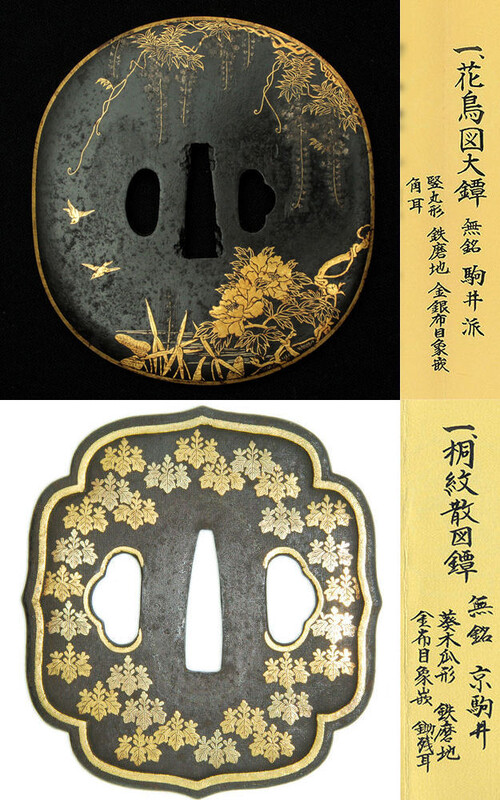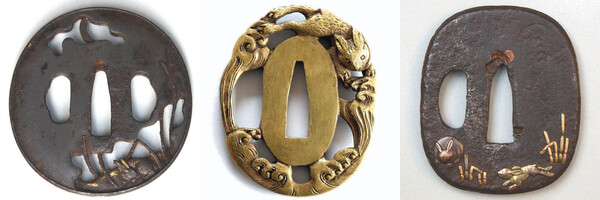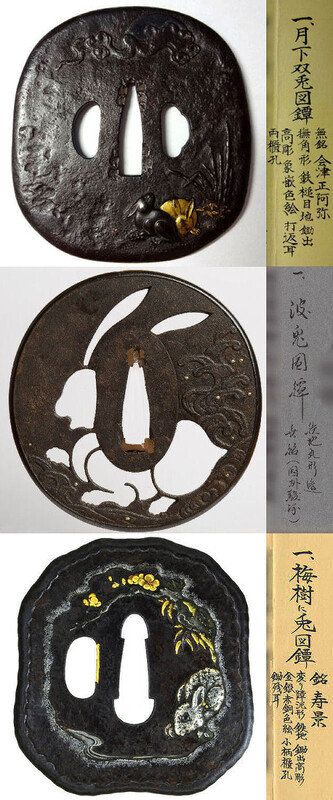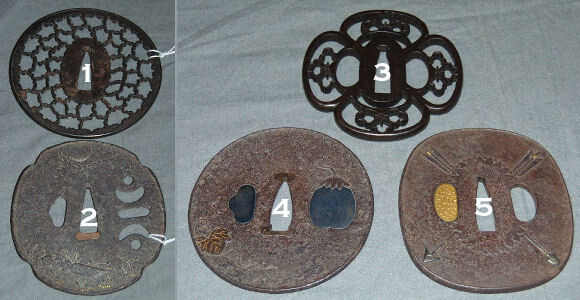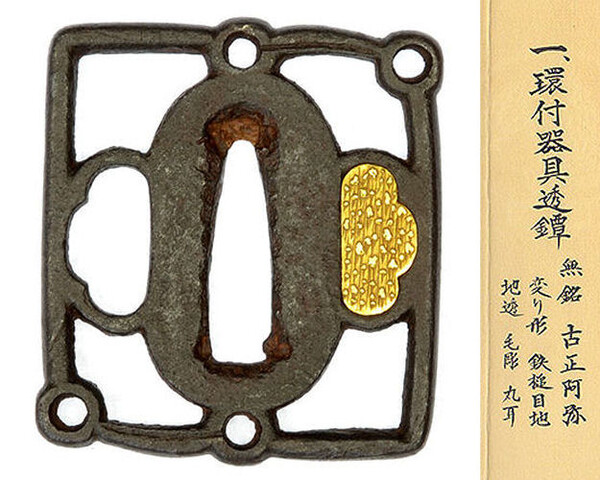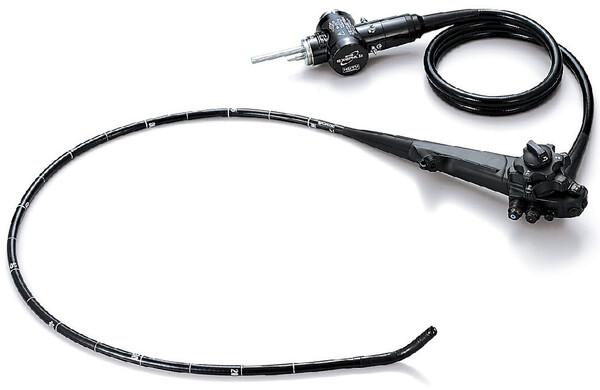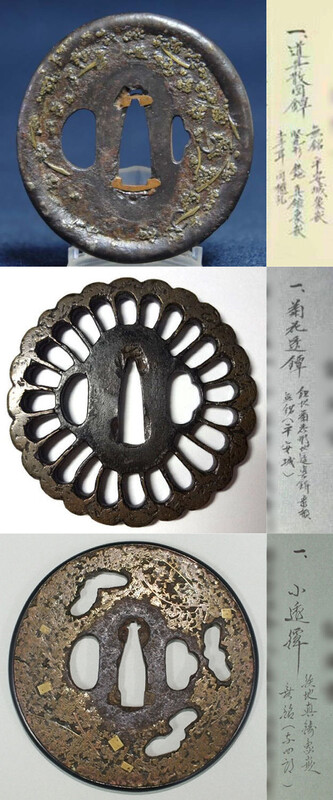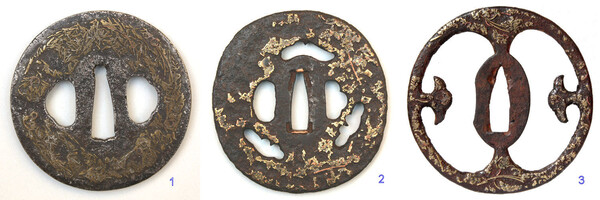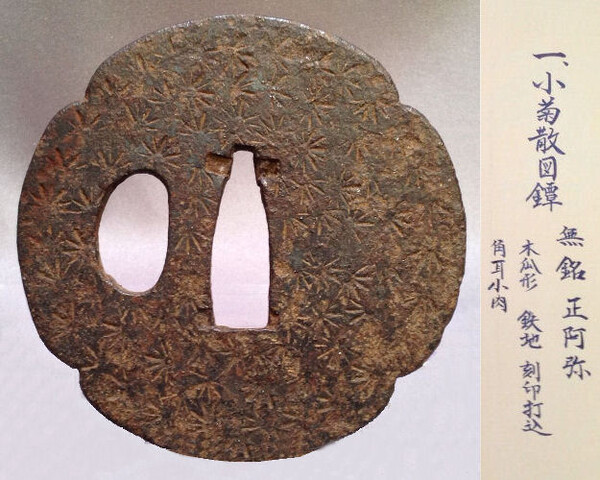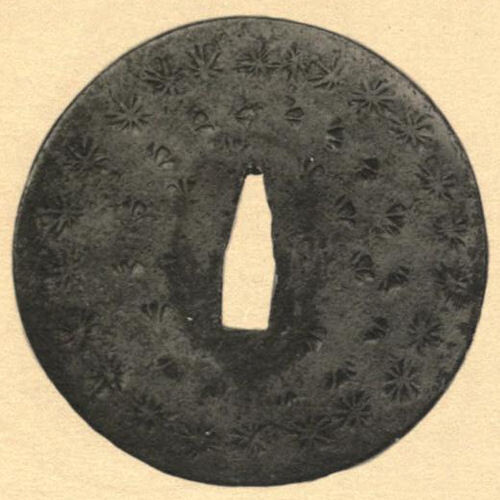-
Posts
762 -
Joined
-
Last visited
-
Days Won
4
Content Type
Profiles
Forums
Events
Store
Downloads
Gallery
Everything posted by MauroP
-
Ciao Luca, I've found paired vertical slits sukashi referred as 霞文 - kasumi-mon (mist), or 楷棒 - kaibō (the meaning should just be sticks) in NBTHK papers. On the tsuba found in the book "Tsuba no Bi" the sukashi is referred as 定規 - jōgi (rulers). Just take the explanation you like more... The mei could be X重作 - (...)shige saku Mauro
-
Actually the paper reports: 銘 正阿弥 (以下木明) so the tsuba is signed indeed. But I'm unable to understand the statement in brakets. Mauro
-
Komai and Kyō-kenjō are probably overlapping attributions. Here below two paperer tsuba with attribution Komai-ha and Kyō Komai respectively. Bye, Mauro
-
Here below 3 tsuba with hare/rabbit from my collection and 3 more ones found on the net, papered respectively as Aizu-Shōami, Inshū Suruga and signed Toshikage. Bye, Mauro
-
My guess is 吉次 - Yoshitsugu, possibly Akao school. The sukashi could be kukusaru (括猿). Bye, Mauro
-
No. 1 Bushū-Itō school, late Edo, depicting 3 oubergines (三茄子透 - mitsu nasubi sukashi). Often those tsuba have very faint inscriptions, so check thoroughly if a mei is present. No. 2 probably Meji or later, depicting a prunus branch (枝梅透 - eda ume sukashi); the supposed straw hat should be part of a branch with a blossom bud. Just my opinion. Bye, Mauro
-
The flower depicted is clematis (tessen - 鉄線), quite common in tōsōgu. I'm with the late Chōshū school hypotesis (very late Edo or Meji). Bye, Mauro
-
The signature is 藻柄子入道宗典製 - Sōheishi Nyūdō Sōten sei. Probably gimei. Nice piece, anyway. Mauro
-
Here what I can read: 黒塗小刻脇指拵 - kuro nuri ko-kizami wakizashi koshirae 縁頭 ?銅 赤銅地 - fuchikashira ??? shakudō-ji 目貫 ??図 ?銅 赤銅地 - menuki ??? zu ??? shakudō-ji 鐔 ?銅地 丸形 - tsuba ???-ji maru-gata (小柄穴) - (kozuka-ana) The elusive kanji could be 真, so 真銅 = shinchū. Bye, Mauro
-
The origami specify the tecnique: 高彫毛彫 焼き手仕上 - takabori kebori yakite shiage.
-
One more papered Naoaki here: http://www.e-sword.jp/tsuba/1110-6032.htm Mauro
-
Hi Luis, nice tsuba here. My guess is: n.o 1 Kyō-sukashi; n.o 2 Aizu-Shōami (is it signed?); n.o 3 Kyō-Shōami (or just Shōami); n.o 4 signed Yamashiro (no) Kuni Fushimi jū Kaneie; n.o 5 Umetada (possibly Shigenari). Just my not-so-educated opinion. Bye, Mauro
-
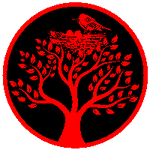
The One You Regret The Most
MauroP replied to lonely panet's topic in General Nihonto Related Discussion
https://m.youtube.com/watch?v=Q3Kvu6Kgp88 -
It's a test, something like "find the intruder"? (the moon has eyes and mouth)
-
That,s the kind of endoscope I'm familiar with. Are we talking of the same kind of instrument? Mauro
-
The workmanship remind Bushū Itō school (signed 正寿). See http://www.shibuiswords.com/haynesTsu52.html Bye, Mauro
- 1 reply
-
- 1
-

-
Ben, Masakata Bushū-Itō school, not Chōshū. The other tsuba could be Edo Higo or Kumagai school. Bye, Mauro
-
Maybe a rudder (舵透図 - kaji sukashi no zu)? Mauro
-
There are some errors scattered in the text (at least I think so): p. 14 - tsuba Shingen, but nothing to do with the design known as the “centipede”; p. 20 - the image is mirrored left-right (difficult to read properly the signature); p. 21 - worth to say the complete mei should be Shōami Shigenobu; p. 25 - the complete mei should be Joi Nagaharu (with Nagaharu - 永春 in form of seal); p. 29 - 柳川直春 reads Yanagawa Naoharu, not Naohara; p. 41 - the maker is Kaji´emon, not Kakiemon; p. 42 - the mei in omote should be 干英子野村包教 - Kan'eishi Nomura Kanenori, not Kan-ishi Nomura Kanemobu; p. 43 - Natsuo, as pointed out by Ford; p. 45 - the mei should be Masachika (正親), not Malachi. It would be fine if some advanced fellows here in the forum could confirm and send a note to the Bilbao Fine Arts Museum. Mauro
-
The expressions gomoku-zōgan (五目象嵌), fukiyose-zōgan (吹寄象嵌) or hokori-yoshirō (埃与四郎) can be interchangeably used to define this style of inlay. I've found only 3 tsuba with NBTHK paper, two attributed to Heianjō and one to Yoshirō. Anyway all the papers report just shinchū-zōgan. Here below 3 tsuba in my collection: The no. 1 is a plan maru-gata kaku-mimi tsuba with a shiny ground plate (silver plated?) and symmetrical hitsu-ana. The no. 2 has quite classical ko-sukashi of Shōami school. The no. 3 is a big nikubori ji-sukashi tsuba. The tsuba above have nothing in commom but the same kind of inlay, and in my opinion this support the hypotesis that gomoku-zōgan was just a way to "pimp" old tsuba. Bye, Mauro
-
The theme is usually referred as ōka ryūsui - 桜花流水 Bye, Mauro
-
Hi Aldwin, here below a tsuba with similar decoration papered Shōami (when you don't know, say elephant or Shōami...): Helen Gunsalus in her "Japanese Sword-Mounts in the Collections of Field Museum" (1923) take this kind of decoration as an early type (see https://archive.org/stream/japaneseswordmou16guns#page/28/mode/2up) I don't like the Shōami-take-them-all theory but I what I know? Bye, Mauro
-
Beginner's luck, I suppose


